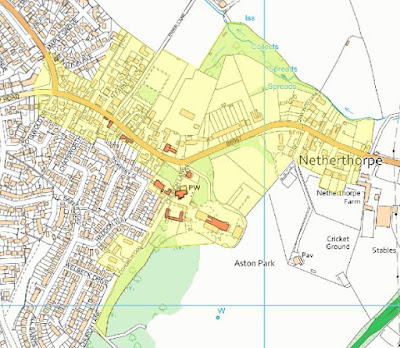 |
| The CWCG Portland stone headstone for Private J. Belk |
Having had a good wander around Aston Hall, All Saints church and Church Lane on a nice sunny afternoon in Aston, to photograph some of its historic buildings for the British Listed Buildings website and to look at its buildings stone, I set off towards Swallownest along Worksop Road.
The Grange, which dates to the early C18 with C19 additions and is Grade II Listed, is built in a very restrained Queen Anne style that lacks the bold architectural elements typical of this period and, as another example of pink Rotherham Red sandstone, I just took a few general record photographs and continued along the road.
Before coal mining was established as the principal economy in the area, Aston was traditionally a farming village and the vernacular architecture, built with Rotherham Red sandstone and red pantile roofs, reflects this. Although not listed, various converted agricultural buildings, farmhouses and cottages, which give the village its essential character, line Worksop Road and form the heart of the Aston Conservation Area.
One house attracted my attention in particular, not for the reason that it is listed or otherwise possesses any architectural merit, but because its gable end has been partially rendered - quite bizarrely - in a fashion that I would expect to see in a house by Antoní Gaudí in Barcelona and not in the Aston Conservation Area.
A little further down Worksop Road, I walked by an archway that I had never noticed before when passing through Aston on the bus but, when seeing the sign on the gate to inform me that Commonwealth War Graves Commission (CWGC) headstones are located there, I took a quick photo of the stone used to build the arch – which may not be Rotherham Red sandstone – and immediately went to investigate Aston-cum-Aughton Cemetery.
Of the five CWCG headstones located here, four are made of Portland limestone and one is Darley Dale sandstone but I was more interested in the discovery of the headstone of Private J. Belk of the Notts. and Derby Regiment. I had come across this regimental crest before, at Woodhouse Cemetery, but it is made in French granite and the details are very difficult to see.
Returning to Worksop Road, the next set of Grade II Listed buildings on my list to photograph were the asymmetrical terrace of two and three storied houses, which are recorded by Historic England as Nos. 22-24 Worksop Road (c1800) and being built in an estate housing style by John Carr – the eminent architect responsible for Aston Hall and the old rectory now known as High Trees.
Passing the Grade II Listed mid C18 South Farm House, where I could only get a glimpse behind the rendered house on the roadside, I also stopped to photograph one of its outbuildings – included on the National Heritage List for group value only.
I carried on along Worksop Road and down Aughton Lane until I reached the William Layne Reading Room. Although it is rendered, except for the main door surround, and I wouldn't therefore normally include it in this Language of Stone Blog, this old school is the office of the Parish Council and is used regularly by the Aston-cum-Aughton History Group, for illustrated talks and for various displays during the Heritage Open Days festival.
Next to the William Layne Reading Room is the Aston-cum-Aughton War Memorial, which was erected in 2011 to commemorate the fallen from both World Wars and subsequent conflicts and is made of an unknown medium grained grey granite.
Having spent only an hour and ten minutes exploring the listed buildings in Anston Conservation Area, I finished my day by walking back to Swallownest, via two Grade II Listed mileposts - a mid C19 squat pillar made from Permian dolomitic limestone on Worksop Road, which seems to have had its cast iron plaque removed, and another one on Mansfield Road that was made in cast iron during the late C19.











No comments:
Post a Comment